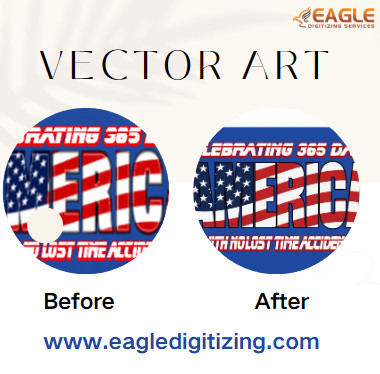Embroidery Digitizing Hacks: Minimize Stitch Count Like a Pro
Mastering the Art of Efficient
Embroidery
Embroidery digitizing is a blend of art and technology,
requiring a meticulous balance between design intricacy and production
efficiency. One of the most crucial aspects of this balancing act is managing
stitch count. Efficient embroidery isn't just about producing beautiful
designs; it's about creating them smartly.
Why
Reducing Stitch Count Matters
Saving Time on Production
Every stitch counts—literally. Reducing the number of stitches in a
design can significantly cut down production time. This efficiency is
particularly vital for large orders or when meeting tight deadlines. Less time
spent on each item translates to higher productivity overall.
Lowering Costs and Increasing
Profit Margins
Fewer stitches mean reduced wear and tear on
embroidery machines, less thread usage, and shorter production times.
All these factors contribute to lowering operational costs. By optimizing
stitch count, businesses can enhance their profit margins without compromising
on quality.
Enhancing Fabric Durability
Heavy stitch counts can compromise the integrity of the fabric,
leading to puckering or stiffness. By reducing the stitch count, you can
maintain the fabric’s flexibility and longevity, ensuring the final product not
only looks good but feels good too.
Understanding
Stitch Count in Embroidery Digitizing
What is Stitch Count?
Stitch count refers to the total number of stitches required to
complete an embroidery design. It’s a critical
factor that impacts the design’s complexity, production time, and overall cost.
Factors Affecting Stitch Count
Several elements influence stitch count, including design complexity,
stitch type, fabric type, and digitizing techniques. Understanding these
factors is essential for optimizing your designs efficiently.
The Impact of High Stitch Count
on Embroidery Quality
High stitch counts can lead to excessive fabric wear, increased
production time, and higher costs. They can also make the fabric stiff and
uncomfortable. Balancing stitch count is key to maintaining both quality and
efficiency.
Choosing
the Right Design
Simplifying Complex Designs
Complex designs are visually appealing but often come with high stitch
counts. Simplifying these designs without losing their essence can
significantly reduce the number of stitches. Focus on essential elements and
eliminate unnecessary details.
Prioritizing Essential Elements
Identify and prioritize the most critical parts of the design.
Highlighting these elements can create a striking design with fewer stitches,
ensuring that the most important aspects stand out.
Using Negative Space Effectively
Negative space can be a powerful tool in design. By creatively using
the empty areas around your design, you can reduce stitch count while enhancing
the overall visual impact.
Optimizing
Design for Embroidery
Selecting Appropriate Fonts
Choosing the right fonts is crucial. Simple, bold fonts require fewer
stitches and are easier to digitize than intricate, delicate fonts. Stick to
fonts that are legible and stitch-friendly.
Simplifying Intricate Details
Details like small text and fine lines add to the stitch count.
Simplifying these elements helps reduce the overall stitch count and makes the
design cleaner and more elegant.
Avoiding Small Text and Fine
Lines
Small text and fine lines often require dense stitching, which can be
problematic on certain fabrics. Opt for larger, bolder elements that are easier
to digitize and stitch.
Using
Efficient Stitch Types
Running Stitch: The Foundation
of Efficiency
Running stitches are the simplest and most efficient type of stitch,
ideal for outlines and simple details. They use fewer stitches and are less
likely to distort the fabric.
Satin Stitch: Balancing Coverage
and Stitch Count
Satin stitches provide good coverage and a smooth finish but can
quickly increase stitch count. Use them judiciously for areas that need a
sleek, polished look without overloading the fabric.
Fill Stitch: Choosing the Right
Density
Fill stitches are used for larger areas and backgrounds. Adjusting the
density of fill stitches can help reduce the stitch count without compromising
coverage. Use a balanced density to maintain both efficiency and design
integrity.
Adjusting
Stitch Density
The Goldilocks Principle:
Finding the Perfect Density
Stitch density needs to be just right—not too high, not too low. Too
dense and the fabric puckers; too sparse and the design lacks detail. Find the
perfect balance for each design to ensure optimal results.
Balancing Coverage and Fabric
Stability
Balancing stitch density with fabric stability is crucial. Ensure that
your designs provide enough coverage without causing the fabric to become too
stiff or prone to distortion.
Using Variable Stitch Lengths
Incorporating variable stitch lengths can add texture and dimension to your designs while reducing stitch count. Experiment with different lengths to find what works best for your project.
Minimizing
Color Changes
Grouping Colors for Fewer Thread
Changes
Minimize the number of thread changes by grouping similar colors
together. This not only reduces stitch count but also speeds up the embroidery
process and reduces the risk of errors.
Using Blended Threads for
Gradient Effects
Blended threads can create beautiful gradient effects with fewer
stitches. By carefully selecting and blending thread colors, you can achieve a
rich, multi-dimensional look without increasing the stitch count.
Optimizing
Underlay Stitches
Choosing the Right Underlay for
Stability
Underlay stitches provide a foundation for the main design, enhancing
stability and ensuring the top stitches lay smoothly. Choosing the right type
of underlay is crucial for reducing the overall stitch count while maintaining
design quality.
Reducing Underlay Density
Without Sacrificing Quality
Experiment with underlay densities to find the minimum necessary for
stability. Reducing underlay density can significantly cut down on stitch count
without sacrificing the integrity of the design.
Simplifying
Pathing and Sequencing
Efficient Pathing: Reducing Jump
Stitches
Efficient pathing minimizes jump stitches, which can be time-consuming
and add unnecessary stitches. Plan your stitch path to reduce the number of
jumps and streamline the embroidery process.
Sequencing for Minimal Movement
Optimizing the sequencing of stitches reduces the need for the embroidery machine to move back and forth, saving time and reducing stitch count. Logical sequencing ensures a smooth, efficient workflow.
Leveraging
Software Tools
Using Auto-Digitizing Features
Wisely
Auto-digitizing features can save time but may not always produce the
most efficient stitch count. Use these features wisely and make manual
adjustments to optimize the design.
Manual Adjustments for Optimal
Results
Manual digitizing allows for greater control over stitch count and
design details. Fine-tune your designs manually to achieve the best balance of
quality and efficiency.
Exploring Advanced Software
Capabilities
Advanced digitizing software offers a
range of tools and features for optimizing stitch count. Take the time to
explore these capabilities and incorporate them into your workflow.
Choosing
the Right Embroidery Machine
Machine Capabilities and Stitch
Efficiency
Different machines have varying capabilities regarding stitch
efficiency and maximum stitch count. Choose a machine that matches your
production needs and can handle the intricacies of your designs efficiently.
Leveraging Machine Features for
Optimal Performance
Modern embroidery machines come with features like automatic thread
cutting and color changes. Leverage these features to streamline production and
reduce overall stitch count.
Utilizing
Appliqué Techniques
Combining Appliqué with
Embroidery
Appliqué can significantly reduce stitch count by using fabric pieces
to cover large areas of the design. Combine appliqué with embroidery to create
detailed, textured designs with fewer stitches.
Reducing Stitch Count with
Fabric Layers
Using fabric layers in appliqué reduces the need for dense fill
stitches, cutting down on stitch count and production time. This technique adds
depth and interest to your designs while maintaining efficiency.
Experimenting
with Embroidery Techniques
Using Open Stitches for a
Lightweight Feel
Open stitches create a lightweight, airy feel and reduce stitch count.
Experiment with different open stitch techniques to add variety and interest to
your designs without adding bulk.
Incorporating Textures with
Lower Stitch Count
Incorporate textures through creative stitch patterns and techniques
that use fewer stitches. This approach adds depth and dimension to your designs
while keeping stitch count manageable.
Testing
and Iterating Designs
Running Test Samples for Quality
Check
Always run test samples to check the quality and efficiency of your
designs. Test samples reveal potential issues with stitch count, density, and
fabric behavior, allowing for adjustments before full production.
Adjusting Designs Based on Test
Results
Use feedback from test samples to refine your designs. Adjust stitch
count, density, and other factors based on real-world results to ensure optimal
performance in production.
Balancing
Aesthetics and Efficiency
Ensuring Visual Appeal with Fewer
Stitches
Achieving a visually appealing design with fewer stitches is an art.
Focus on essential elements and use creative techniques to maintain the beauty
and impact of your designs while optimizing stitch count.
Avoiding Over-Simplification
While reducing stitch count is important, avoid over-simplifying designs to the point where they lose their appeal. Strive for a balance that maintains the integrity and attractiveness of the design.
Common
Pitfalls and How to Avoid Them
Over-Digitizing: When Less is
More
Over-digitizing can lead to excessive stitch counts and a cluttered
appearance. Aim for simplicity and clarity in your designs, using the minimum
number of stitches necessary to achieve the desired effect.
Ignoring Fabric Behavior: Choosing
the Right Fabric
Different fabrics behave differently under embroidery. Ignoring these
characteristics can lead to issues like puckering and distortion. Choose
fabrics that complement your designs and adjust the stitch count accordingly.
Future
Trends in Embroidery Digitizing
Innovations in Digitizing
Software
The field of embroidery digitizing is constantly evolving with new
software innovations. Stay informed about the latest advancements to leverage
new tools and techniques for optimizing stitch count.
Sustainable Practices in
Embroidery
Sustainability is becoming increasingly important in embroidery
digitizing. As environmental consciousness grows, there's a shift towards
sustainable practices in embroidery, including reducing waste and minimizing
resource consumption.
Mastering
Efficiency in Embroidery Digitizing
Efficiency in embroidery digitizing isn't just about cutting corners;
it's about finding the perfect balance between quality and productivity. By
understanding the factors that influence stitch count and implementing
strategies to optimize it, embroiderers can master the art of efficient digitizing.
In the dynamic world of embroidery, efficiency isn't just a goal; it's
a necessity for staying competitive and meeting the demands of clients. By
embracing efficiency, embroiderers can achieve better results, improve
profitability, and elevate the overall quality of their work.


.png)
